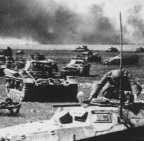DeletedUser44
Posts: 397
Joined: 5/27/2021
Status: offline

|
quote:
ORIGINAL: Lovenought
Historically, Germany had insufficient motorisation and truck production. They made up for this (and other shortfalls) by confiscating vehicles from everyone they defeated and occupied. However, this made maintenance an utter nightmare, due to problems of familiarity and organising spare parts. What do you do when a truck made in Norway 5 years ago breaks down on the side of the road outside Grozny? Sometimes you can take a part from a French or Soviet truck and make it work, but sometimes it just needs a unique part that can't be found.
The Soviets and Allies, meanwhile, were working with a smaller number of variants, so it was much easier to ensure the right spare parts were available.
Have you read any of Nigel Askey's 'Operation Barbara: The Complete Statistical Analysis and Military Simulation' ?
(disclaimer: I do not automatically endorse all of his conclusions)
In Volume IIB he has about 10 pages devoted to auto / truck production and capabilities of both Germany and Soviet Union. Some of his stuff is interesting, but what really stands out (of course, it is BOLDED in his book) when he draws some unconventional conclusions, such as:
quote:
"Furthermore, the Germans were no shorter of spare parts for their mixed bag of domestic and foreign built vehicles than the Soviets were for their old home grown or newer licence built ones."
I think that is based on his earlier assertions of:
- 23.1% of all Red Army motor vehicles inoperable on eve of war. (citing DM Glantz, "Stumbling Colossus")
- 45% of the entire Soviet truck park were inoperable in June 1941, (no citing)
- with stocks of tyres (tires?) meeting only about 25% of demand. (no citing)
His work is a little frustrating because the data-points he uses to draw conclusions from do not, consistently, have citations.
Some of his content I find credible, but there are some portions I just don't know about. Doesn't mean it is all fiction, just you have to be prepared use your own judgement.
Oh, and he is currently mad at me because I didn't give him 5 stars. :)
|
 Printable Version
Printable Version






 I am curious as to why the German repair rate is so much lower than the Soviet.
I am curious as to why the German repair rate is so much lower than the Soviet.




 New Messages
New Messages No New Messages
No New Messages Hot Topic w/ New Messages
Hot Topic w/ New Messages Hot Topic w/o New Messages
Hot Topic w/o New Messages Locked w/ New Messages
Locked w/ New Messages Locked w/o New Messages
Locked w/o New Messages Post New Thread
Post New Thread